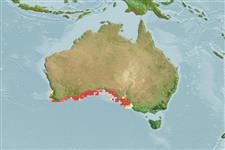分類 / Names
俗名 | 同種異名 | Catalog of Fishes(屬, 種) | ITIS | CoL | WoRMS | Cloffa
Teleostei >
Syngnathiformes (Pipefishes and seahorses)
海龍目 (Pipefishes and seahorses) >
Syngnathidae (Pipefishes and seahorses)
海龍科 (Pipefishes and seahorses) > Syngnathinae
Etymology: Phycodurus: Greek, phykon = seaweed + Greek, dora = skin (Ref. 45335).
Eponymy: Ludwig Glauert (1879–1963) was born in England and trained as a geologist. [...] (Ref. 128868), visit book page.
More on author: Günther.
Environment: milieu / climate zone / depth range / distribution range
生態學
海洋 礁區魚類; 非遷移的; 深度上下限 4 - 30 m (Ref. 9002). 亞熱帶的; 32°S - 39°S, 115°E - 140°E (Ref. 57011)
Eastern Indian Ocean: endemic to southern Australia.
東印度洋: 澳洲南部的特有種。
Length at first maturity / 大小 / 重量 / 年齡
Maturity: Lm ?, range 20 - ? cm
Max length : 35.0 cm TL 雄魚/尚未辨別雌雄; (Ref. 9002)
Usually occur over sand patches close to reefs with kelp, feeding on mysids and other crustaceans. Ovoviviparous (Ref. 205). The male carries the eggs in a brood pouch which is found under the tail (Ref. 205). One of the most spectacular examples of camouflage: neither prey nor predators recognize it as a fish.
通常用海藻出現沙子區塊鄰近礁石之上, 吃糠蝦與其他的甲殼動物。 卵胎生的.(參考文獻 205) 雄魚帶卵在一個孵卵袋是在尾部下面發現.(參考文獻 205) 最引人注目的例子之一偽裝: 沒有一個獵物及掠食者認得它作為一個魚。
Life cycle and mating behavior
成熟度 | 繁殖 | 產卵場 | 卵 | 孕卵數 | 仔魚
About 250 eggs are incubated by males on the underside of the tail, where they are embedded in spongy tissue (Ref. 31838).東印度洋: 澳洲南部的特有種。
Kuiter, R.H., 1993. Coastal fishes of south-eastern Australia. University of Hawaii Press. Honolulu, Hawaii. 437 p. (Ref. 9002)
IUCN 瀕危狀態 (Ref. 130435: Version 2024-2)
無危 (LC) ; Date assessed: 12 May 2016
人類使用
漁業: 沒有興趣; 水族館: 商業性
工具
特別的報告
下載 XML
網路資源
Estimates based on models
Preferred temperature (Ref.
123201): 16.3 - 18.5, mean 17.8 °C (based on 104 cells).
Phylogenetic diversity index (Ref.
82804): PD
50 = 1.0000 [Uniqueness, from 0.5 = low to 2.0 = high].
Bayesian length-weight: a=0.00447 (0.00175 - 0.01142), b=2.99 (2.77 - 3.21), in cm total length, based on LWR estimates for this (Sub)family-body shape (Ref.
93245).
營養階層 (Ref.
69278): 3.3 ±0.45 se; based on food items.
Generation time: 1.0 ( na - na) years. Estimated as median ln(3)/K based on 1
growth studies.
回復力 (Ref.
120179): 高度, 族群倍增時間少於 15個月 (Preliminary K or Fecundity.).
Fishing Vulnerability (Ref.
59153): Low vulnerability (18 of 100).
Nutrients (Ref.
124155): Calcium = 22.8 [9.5, 42.9] mg/100g; Iron = 0.23 [0.12, 0.42] mg/100g; Protein = 18.3 [17.1, 19.6] %; Omega3 = 0.269 [0.137, 0.505] g/100g; Selenium = 7.82 [3.39, 18.95] μg/100g; VitaminA = 42.6 [10.2, 182.7] μg/100g; Zinc = 0.623 [0.397, 0.991] mg/100g (wet weight);
